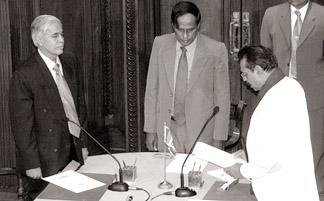|
observer |
|
|
|
|
|
OTHER LINKS |

|

|

|
|
Glimpse of History from ANCL Archives: Reflections on Executive Presidents ...Mahinda Rajapakse (November 18, 1945 Weerakatiya, Hambantota, Sri Lanka)
The incumbent President, Mahinda Rajapakse hails from a prominent political family in the Southern province. His father Don Alwin Rajapakse was a leading political figure in the Independence struggle and was a Member of Parliament. Prior to his election as the fifth Executive President, Mahinda Rajapakse served as Prime Minister from April 6, 2004 until November 2005 under the Kumaratunga Administration. He was educated at Richmond College, Galle before moving to Nalanda College, Colombo and later Thurstan College, Colombo. As he celebrates one year in Office, President Rajapakse is trying hard to lay a firm foundation for a political solution to the national question, having reached, for the first time in the Sri Lankan political history, a Southern consensus.
Chandrika Bandaranaike Kumaratunga (born 29 June 1945) The fourth Executive President Chandrika Bandaranaike Kumaratunga won with an unprecedented majority at the Presidential Election held in November, 1994. She is the longest served Executive President (November 12, 1994 to November 19, 2005). Her forte was her educational reforms and foreign policy architectured by Foreign Minister Lakshman Kadirgamar that led to the worldwide ban of the LTTE. Dingiri Banda Wijetunga (born on February 15, 1922) He became the third Executive President of Sri Lanka May 01, 1993 following the assassination of President Premadasa by a suicide bomber and continued to serve in the position till November 12, 1994. He eased the passage of regime change. He also followed the economic and political agenda of the United National Party.
Ranasinghe Premadasa (June 23, 1924-May 1, 1993) JRJ's PM Ranasinghe Premadasa became the second Executive President .His major development programmes were the Gam Udawa and Janasaviya. He was famous for being industrious and was totally dedicated to the ideals he believed in. Junius Richard Jayewardene (September 17, 1906-November 1, 1996), Better known as JR, was the first Executive President of Sri Lanka from 1978 until 1989. He was considered as the architect of open economy which he introduced in 1977. During his tenure, mega development projects such as the Mahaweli were launched. He signed the Indo-Sri Lanka Agreement and introduced the Provincial Council system as a solution to the national question. **** Executive Presidency The office of the Executive President was established in 1978 as the new Constitution came into being. It was a marked shift from a Westminster-based political system into a new political system modelled on France .As in France , a new office was created independent from Parliament. Head of the State, the Head of the Executive, the Head of the Government, and the Commander-in-Chief of the Armed Forces, the Executive President is vested with a wide range of powers which include: * Making policy Statement in Parliament at the commencement of each parliamentary session. * Presiding over ceremonial sittings of Parliament * Appointing and sanctioning Ambassadors, High Commissioners, Plenipotentiaries and other diplomatic representatives * declaring war and peace * making important appointments including Ministers of the Cabinet and the Chief Justice and Judges of the Supreme Court * granting amnesty or reducing punishment imposed The President also enjoys immunity from all legal proceedings and can not be sued in his official or private capacity. |













